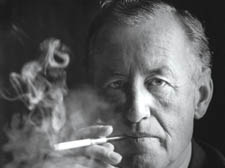|
|
 |
| |
 Fleming: debonair charmer Fleming: debonair charmer |
Camden books | Ian Fleming by Andrew Lysett | review | Erno Goldfinger
When architect Erno Goldfinger knocked down some old cottages, James Bond writer Ian Fleming used his literary licence to kill, writes Gerald Isaaman order this book
YOU won’t find it mentioned in the official For Your Eyes Only exhibition at the Imperial War Museum, now being staged to celebrate the life and crazy fun-loving times of Ian Fleming, creator of Commander James Bond, the licensed to kill British agent.
But Hampstead played a significant part in the tortuous sex life of Fleming, born a century ago this month, and in his hatred of villainous Goldfinger, the subject of the first of the gadget-packed Bond movies seen by millions round the world.
Although he was born in Mayfair, Fleming did spend his early life living in Hampstead, significantly at Pitt House, in North End, until his MP father Valentine Fleming was killed in the First World War, his mother moving in 1917 to Chelsea.
When Pitt House came on the market in November 1908, it was described by local estate agents Lowe, Goldschmidt & Howland as “the house in which Great Britain lost America” – a historical reference to the fact that if William Pitt had not become something of a recluse there in the 1770s the government would not have imposed its infamous tea tax and the Americas would have been saved.
For these arcane facts you have to talk to Andrew Lycett, outstanding author of the compelling and much admired definitive biography of Fleming, first published in 1995 and now updated in paperback for Fleming’s centenary year and exhibition, which runs until March next year.
So why do the 007 Bond novels and films have such an enduring existence today?
“Although I am a great advocate of the books, I am under no illusion that James Bond would not be the global figure he is today without the films,” Lycett told me at his home in Regent’s Park Road, Primrose Hill. So what of Goldfinger?
Fleming in fact based him on the Hungarian-born architect Erno Goldfinger, who knocked down old cottages in Willow Road, Hampstead, to the dismay of local residents to build his iconic block of flats in 1932, one of which was his home and is now owned by the National Trust as a listed national architectural treasure.
“I have read, but I have not seen any substantiating evidence, that Fleming was a member of the Hampstead Preservation Society [forerunner of today’s Heath and Hampstead Society],” Lycett reveals. “That led him to take such a strong stand against Erno Goldfinger’s flats at No 2 Willow Road. He certainly took against Goldfinger, but that was a more personal thing as Goldfinger was married to a cousin of a golfing friend of his.
“He used Goldfinger’s name as the villain of his novel, albeit with the first name Auric.
“The real Goldfinger threatened to halt publication of the novel. Fleming’s publisher, Cape, fobbed him off, much to the anger of Fleming, who wanted Cape to insert a slip explaining what Erno had done and changing his name to Goldprick throughout.”
Lycett has many amorous stories to tell about the 6ft tall old Etonian Fleming who was such a debonair charmer.
His first love was for a Jewish girl named Lisl Jokl, who Fleming met in Austria when he was 20. The author described her as having “sleepy blue eyes and a romantic face” and she was one of only four people to whom he left a legacy of £500 on his death.
“It was she who opened his eyes to the world and to sex,” says Lycett. “She subsequently came to London in the 1930s and worked as a designer and as a buyer, eventually for Marks and Spencer.”
And then there was Blanche Blackwell, from a Sephardic Jewish heritage, who was probably the last of Fleming’s lovers. He met her in Jamaica, where he wrote his James Bond novels in roughly six weeks a time at Goldeneye, Fleming’s idyllic seashore retreat. Lycett interviewed her and recalls: “Fleming wanted a loving woman and Blanche was very adoring. She looked back increasingly fondly on him and their time together.”
But that was one of many romantic flings following, and partly because of, his wife Ann’s love affair with Hugh Gaitskell, the late Labour Party leader, who lived in Frognal Gardens, Hampstead.
“Ann fell for the Labour leader in retaliation to Fleming’s own affairs,” insists Lycett. “Before Gaitskell’s death in 1963 she visited him at the trade union-owned Manor House Hospital when he was taken sick. Fleming didn’t go with her.” He adds: “Fleming certainly liked women. He did not treat them very well. In this respect, James Bond was like him, though there is a reading of the James Bond books which suggests Bond is really quite loving and protective of his women.”
Does he have a favourite Bond novel and a favourite Bond beauty?
“The most satisfying novel for me is From Russia With Love, for its scope and excitement,” says Lycett. “Connery is the best Bond actor, although I have a sneaking respect for Timothy Dalton.
“Based on my own adolescent fantasies, the Bond girl I fancy most is Claudine Auger, the French woman who played Domino in the 1965 film Thunderball.”
Meanwhile, he waits to be approached by Eon, the Bond film production company, to play a cameo part in one of the movies.
“The Bond connection has taken me to a variety of exotic places,” Lycett says. “Like Fleming himself, I fell in love with Jamaica when I visited it. I hope to be returning there this winter when I lecture about Bond and Fleming on a cruise ship.”
Ian Fleming. By Andrew Lycett. Phoenix £10.99.
More on the Imperial War Museum’s centenary events at
www.ianflemingcentenary.com
|
 |
|
 |
 |
|
 |
|



